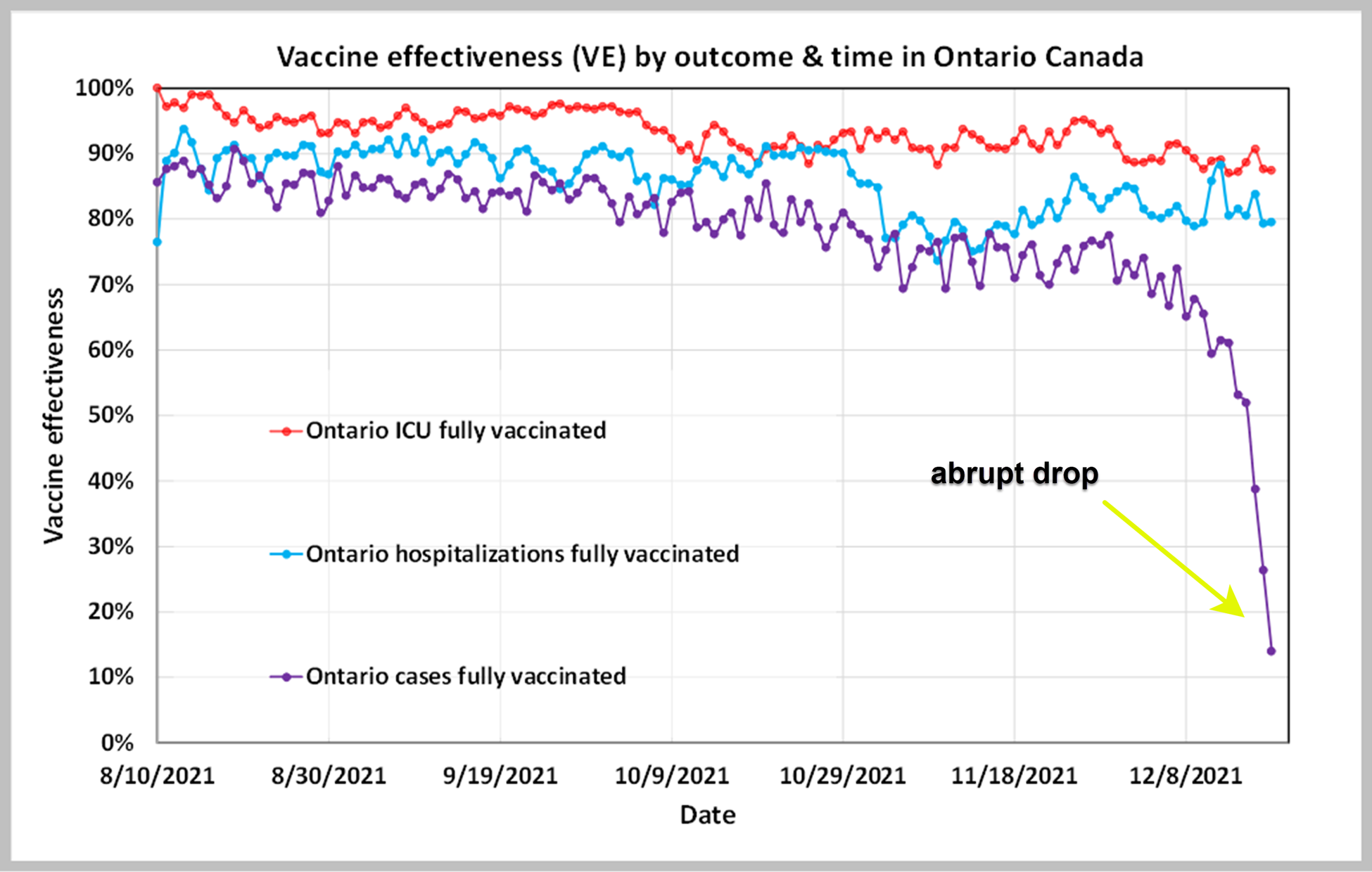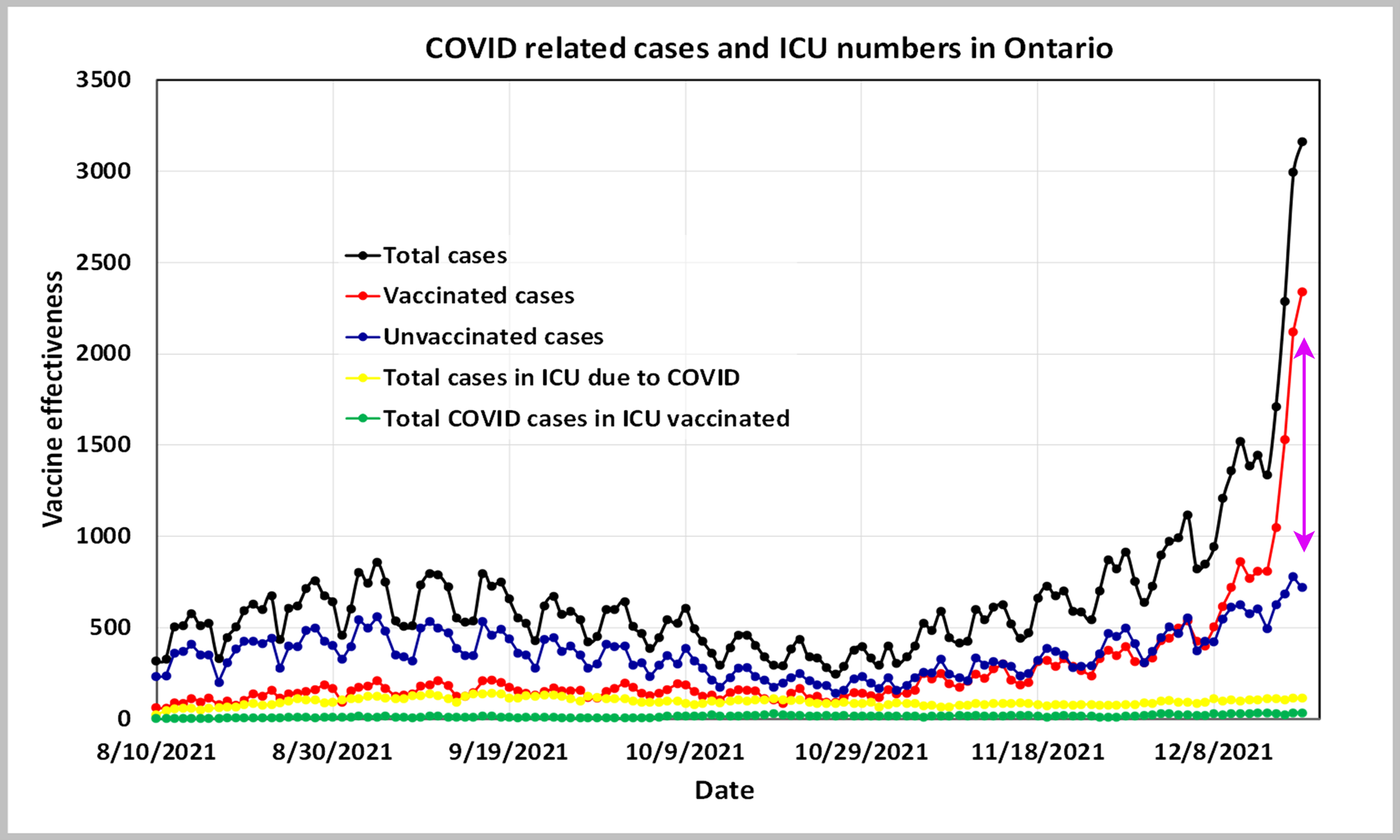The Omicron COVID variant is relatively unknown, but appears to be spreading quickly across the United States and Canada.[1]We look to the province of Ontario for a clue as to what this variant may do in other regions in the near future.
The latest vaccine effectiveness estimates as of Dec. 18, 2021, out of Ontario show high effectiveness against severe cases (hospitalization and ICU hospitalization), but plummeting effectiveness against mild or new cases.[2]This decreasing effectiveness has been observed to a much lesser degree for some time, although the recent sharp drop in effectiveness to below 30% against new cases is noteworthy. This may be an effect of a surge in the Omicron variant in Ontario.[3]
This drop in effectiveness is shown in the graph below, where the vaccine effectiveness in non-severe new cases, shown in purple, drops abruptly. This effect is noteworthy due to its magnitude, where on the last few data points (days) the vaccinated exhibit little (less than 30%) statistical advantage over the unvaccinated against contracting the disease. The blue (hospitalization) and red (ICU) vaccine effectiveness lines have – in contrast – stayed high, in the 80-90% range. So far, the vaccines appear to be protecting individuals quite well against severe infection despite the surge in cases.
However, hospitalization and ICU hospitalization are trailing indicators.
Because more severe cases occur at a time lag compared to new cases, a drop in the vaccine effectiveness against severe outcomes may be observed in one to two weeks. There is no way to know at this time what that drop will be, or even if it will occur, but it should be monitored.

Updated vaccine effectiveness in Ontario Canada, as of Dec. 18, 2021, shows effectiveness against hospitalization and ICU hospitalization is holding between 80% and 90%, but against non-hospitalization, it has dropped abruptly.[4]
Cases soar but ICU numbers have not
Having lower vaccine effectiveness against new cases could have either a small or large impact on the functioning of society and the well being of its people. If the drop in vaccine effectiveness is matched with a sufficiently high case volume, it could lead to relatively more hospitalizations, ICU stays and deaths.
This has not been the case so far. The graph below shows total new cases, the vaccinated and unvaccinated cases, and ICU related cases. The total case numbers have jumped in the last two weeks. In particular, the proportion of the vaccinated amongst those new cases has risen. This is why the vaccine effectiveness to new cases has dropped.
Note that vaccinated and unvaccinated cases have followed each other closely over this study period, in which vaccination rates have changed very little. We had explained, in this article – Understanding vaccine effectiveness and breakthrough – that as vaccination rates rise, we would expect higher infection rates among the vaccinated. Such would be a consequence of the mathematics of a scenario in which almost everyone becomes vaccinated, and only vaccinated individuals can be infected.
In the last week, however, there has been a suddenly widening delta, as shown by the magenta arrow, between vaccinated new cases to unvaccinated new cases. Given that the vaccination rate is relatively unchanged over this short period of time, we are directly observing the effectiveness drop.
Does it matter?
We do not know yet. The ICU cases due to COVID are shown in yellow, and have not risen to date. It is too soon to conclude what will happen, since severe outcomes are delayed in time.

Updated case and ICU numbers in Ontario as of Dec. 18 shows that case numbers among the vaccinated abruptly surged but ICU cases due to COVID, so far, have not.[5]
To this point, Ontario has not experienced a health-care crisis due to the rising caseloads. However, it is too soon to say whether this will remain true due to severe outcomes being a time delayed phenomenon. Ontario’s situation is likely an analogous example of what to expect from other regions in the U.S. and Canada as Omicron spreads. This situation, therefore, warrants close examination. In particular, we shall watch for:
- Whether or not the vaccine effectiveness against severe outcome will stay high.
- Whether or not the Omicron variant will tend to have a statistical tendency to milder outcomes.
- Whether or not the level of ICU need will rise beyond current capacities.
Ultimately, all three of these related measures will all be indicators of how manageable the new situation is going to be.
References
[1] Scribner, Herb, December 17, 2021, CDC director reveals what to expect with the omicron variant in the next few weeks, Desert News
[2] COVID-19 Vaccine Data in Ontario, Ontario Government, December 18, 2021
[3] Lee, Michael, December 16, 2021, Ontario at ‘leading edge’ of Omicron: ER doctor, CTV News
[4] COVID-19 Vaccine Data in Ontario, Ontario Government, December 18, 2021
[5] Hospitalizations, Ontario Government, December 18, 2021
(Lee Hunt – BIG Media Ltd., 2021)



Like George I am optimistic about this. As a scientist I am strongly supportive of the vaccines and in awe of the brilliant science that went into their development and led to several Nobel prizes. If the current vaccines become less effective the science is there to constantly improve them. That’s how we beat polio and smallpox, but the new approach is a game changer.
Great comments, Brian. I also hope that you are correct, and will watch the data.
Lee; interesting data. The optimist in me see this as a possible inflection point toward the end of the SarsCov2 episode.
So far the Omicron variant appears to be highly contagious even for people who are fully vaccinated, reduced number of severe outcomes (only time and more data will confirm this) and enhanced immunity for those who recover from the disease vaccinated or not. Looks pretty positive at this point in time, again only time and more data will tell the tale.
Thanks George. I hope that the optimist in your comments is correct.